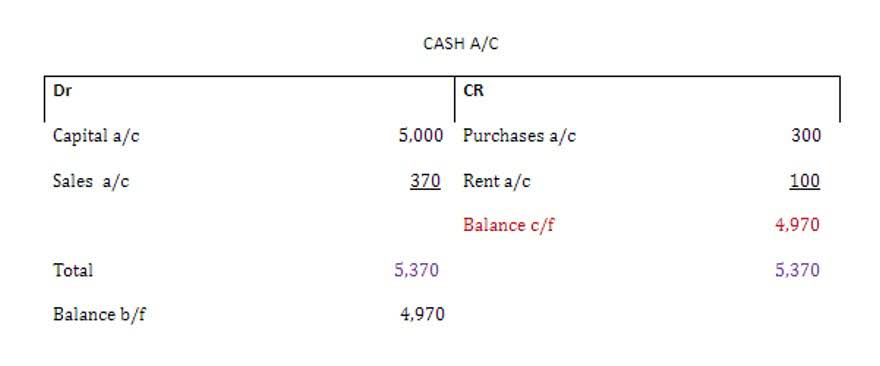What is Accounting Equation? Components, Applications and Examples

IDC MarketScape vendor analysis model is designed to provide an overview of the competitive fitness of technology and suppliers in a given market. The Capabilities score measures supplier product, go-to-market and business execution in the short-term. The Strategy score measures alignment of supplier strategies with customer requirements in a 3-5-year timeframe. I hope by the end of this article you have a clear understanding of the accounting equation.
What is Double-Entry Bookkeeping?
- Include the value of all investments from any stakeholders in your equity as well.
- Although owner’s equity decreases with a company expense, the transaction is not recorded directly into the owner’s capital account at this time.
- The amounts in the general ledger accounts will be used to prepare the balance sheets and income statements.
- Its applications in accountancy and economics are thus diverse.
- If the expanded accounting equation is not equal on both sides, your financial reports are inaccurate.
- By analyzing the loan cost against the potential gains from the new asset, the company can determine if the transaction positively impacts its financial health and equity in the long term.
The 500 year-old accounting system where every transaction is recorded into at least two accounts. You should consider our materials to be an introduction to selected accounting and bookkeeping topics (with complexities contra asset account likely omitted). We focus on financial statement reporting and do not discuss how that differs from income tax reporting. Therefore, you should always consult with accounting and tax professionals for assistance with your specific circumstances. The equation remains in balance thanks to the double-entry accounting (or bookkeeping) system. Regardless of how the accounting equation is represented, it is important to remember that the equation must always balance.
- Accounting software is a double-entry accounting system that automatically generates the trial balance.
- The totals tell us that the corporation has assets of $9,900 and the source of those assets is the stockholders.
- This separation protects members’ personal assets from business liabilities.
- The balance sheet is a more detailed reflection of the accounting equation.
- The three main systems used in business are manual, cloud-based accounting software, and ERP software.
- Many financial figures like asset values or bad debt provisions depend on personal judgment.
Introduction to Double-Entry Bookkeeping

This equation holds true for all business activities and transactions. If assets increase, either liabilities or owner’s equity must increase to balance out the equation. Since ASI’s assets increase by $10,000 and stockholders’ equity increases by the same amount the accounting equation is in balance.

3 Examples of Assets

(The depreciation journal entry includes a debit to Depreciation Expense and a credit to Accumulated Depreciation, a contra asset account). The purpose is to allocate the cost to expense in order to comply with the matching principle. In other words, the amount allocated to expense is not indicative of the economic explain the accounting equation and what makes up each part. value being consumed. Similarly, the amount not yet allocated is not an indication of its current market value.
- As you can see from the examples above, double-entry accounting keeps the books balanced.
- Other names for owner’s equity you may face are also net assets, or stockholder’s equity (for public corporations).
- In other words, we can say that the value of assets in a business is always equal to the sum of the value of liabilities and owner’s equity.
- Issuing new shares or receiving additional capital from owners increases equity, which enhances the company’s financial strength.
- The term capital includes the capital introduced by the business owner plus or minus any profits or losses made by the business.
- Let’s understand how this equation works in a practical scenario with an example.
- The accounting equation is a fundamental concept that states that a company’s total assets are equal to the sum of its liabilities and its shareholders’ equity.
- This bookkeeping method assures that the balance sheet statement always equals in the end.
- Two or more accounts are affected by every transaction carried out by a company so the accounting system is referred to as double-entry accounting.
- Double-entry bookkeeping is a system in which transactions influence two accounts to ensure both sides of the accounting equation are equal.
- At some point, the amount in the revenue accounts will be transferred to the owner’s capital account.
Even when the balance sheet balances itself out, there is still a possibility of error that doesn’t involve the accounting equation. Creating the balance sheet statement is one of the last steps in the accounting cycle, and it is done after double-entry bookkeeping. Double-entry bookkeeping is a system that records transactions and their effects into journal entries, by debiting one account and crediting another. We will now consider an example with various transactions within a business to see how each has a dual aspect and to demonstrate the cumulative effect on the accounting equation.

What Is Return on Revenue: A Simple Explanation
In this sense, the liabilities are considered more current than the equity. This is consistent with financial reporting where current assets and liabilities are always reported before long-term assets and liabilities. A company’s quarterly and annual reports are basically derived directly from the accounting equations used in bookkeeping practices. These equations, entered in a business’s general ledger, will provide the material that eventually makes up the foundation of a business’s financial statements. This includes expense reports, cash flow and salary and company investments. The fundamental accounting equation, https://www.bookstime.com/what-is-bookkeeping also called the balance sheet equation, is the foundation for the double-entry bookkeeping system and the cornerstone of accounting science.
